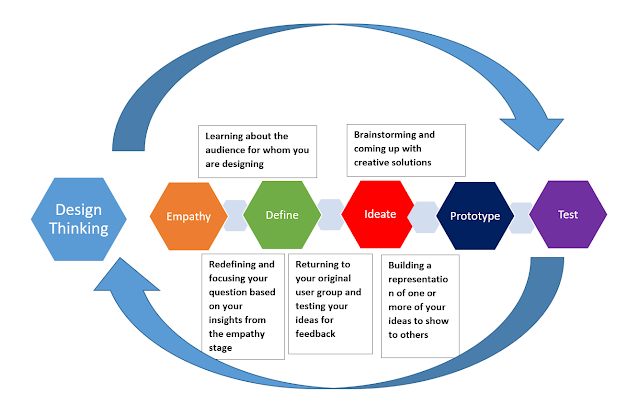Design Thinking for Everyone
 |
| The Process of Design Thinking |
Design Thinking for Everyone
You might have heard about design, many times in your daily life, but have you ever heard about design thinking? What might have come in your mind when you first heard this word? Interestingly, you probably have used design thinking in your daily life but you were unaware of what you just did. Just recall how did you solve a certain problem which never occurred before? Did you gave up or solved it confidently? Ever thought like a designer? What a designer does when he/she intends to design something? Don’t you think that he designs preferring the needs of those who will see or use it? Yes, that is true.
Design thinking is a solution-focused way of solving problems, keeping in view the user preferences. It comes up with solutions after considering all the problems which users face and future challenges. Not only organizations but also individuals can use design thinking to make their life easy and interesting.
Design Thinking process
Design thinking is a process, and it consists of five steps. These five steps may not be followed by individuals as there is no need for formality in personal lives, but the concept of these steps helps organizations move organized. These are
Emphasize:
When we are solving a problem for others, we must give a solution which is compatible with the audience’s interests and do not include our assumptions. Which means we should go and understand what the real problem is and how it creates hurdles for others. We should show empathy while solving a problem so that we can assure our audience that their problem is our problem. For that, market research is necessary. We personally interact with people who face the problem and ask their proposed solution.
Define:
In this step, we now define the core problem in such a way that it seems to be a genuine problem faced by humans.
Ideate:
As the word implies, ideate means we start generating ideas focusing on the problem and analyze alternative ideas so that a user-focused solution may come up with the innovative nature of it.
Prototype:
The word prototype means the first version of any product. A prototype helps understand what the real and final product will look like and function. After generating ideas on solving a certain problem, now we need to actually design a product or perform an experiment to see whether our proposed solutions work or not.
Test:
Finally, when we have developed our prototype, now we have to evaluate and see whether the prototype is working or it needs improvement. So, if something goes wrong we can go back and check where we went wrong.
Now that you have understood design thinking and the steps followed by corporations, we now need to know why design thinking is important or why it is used? Gone are the days when things were so simple. You just enter the market and start earning. But today, until and unless you do not persuade people/customers why should they buy from you, they do not come to you. People are now conscious of what is good and bad for them and also there are many choices for them to make. Therefore, in this era, innovation is the way you enter into the market and capture your share. So, what companies do is, design their products and services in such a way that they solve problems of people. When people see a better solution, they buy from it.
Therefore, design thinking helps in designing products that are innovative.
Individuals can also use design thinking to solve their daily life problems. What about rewarding yourself after you have achieved a certain target in your academic career? Will that not motivate you to improve academically and enjoy learning? That is like design thinking. You are creating value for yourself. And there can be many ways you do it.
In the end, I would like to say that design thinking is somehow like creativity. Because creativity is all about coming up with new ideas,and that is what design thinking does.
References:
This article was generated after getting help from these articles so that any misinformation may not find its way.



Comments
Post a Comment